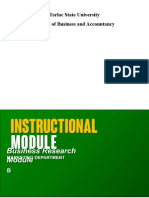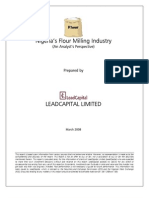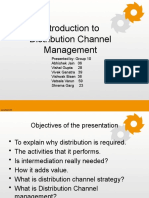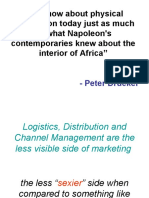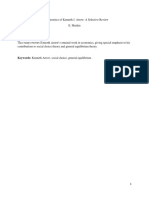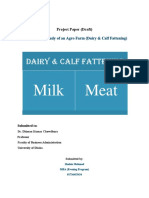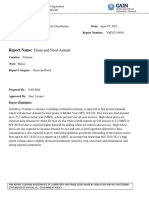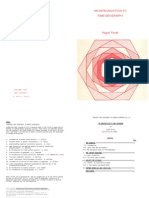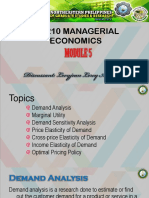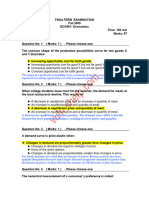Pro Sub 4 Module
Uploaded by
Jan Marcus MagpantayPro Sub 4 Module
Uploaded by
Jan Marcus MagpantayTANAUAN INSTITUTE INC.
J. Gonzales St. City of Tanauan, Batangas
COLLEGE OF BUSINESS
Course Title: DISTRIBUTION MANAGEMENT
Course Code: Prof 4
No. of Credits: 3 units
Teaching Hours :1.5 hours
Professor: Joan Cristine M. Perez MBA
Course Description and Purpose:
Distribution of products and service includes all of the activities that are involved in delivering
a suitable offering to end-customers following the most efficient way. However, in the way of
delivering products and services to the end users, there are some intermediaries or middlemen.
These intermediaries or middlemen are key elements of supply networks. Distribution relates to
selection of those key points or places of supply networks and this forms an important part of
marketing strategy. These supply network points or places means making goods and services
available in the right quantities and qualities at the various locations when customers want them.
Therefore, distribution management reflects strategic marketing aspects. Distribution management is
the systematic management to optimize the efficiency of overall activities of movement of goods from
supplier or manufacturer to point of sale
Course Objective:
MODULE 1: Introduction to Distribution Management
Definition of Distribution Management and its System
The Marketing Mix and its Function in Distribution
The Different Channels of Distribution
Selling through Direct and Indirect Channel
The Patterns of Distribution
Drivers in Distribution Channel
Multi-Channel Distribution
MODULAR OBJECTIVES
At the end of this module students must be able to:
Explain the definition of distribution management and its important role in business operation
Relate marketing mix and its function in the distribution process
Name the difference between Direct and Indirect Channel
Discuss what are the patterns of distribution, drivers of distribution and multi-channel
distribution
TO DO LIST
Write a brief introduction about student’s understanding on the topic
Reading and understanding topics about distribution channel associated with huge
multinational companies such as P&G and Unilever
Take the scheduled quiz
Refer to due dates for the set assignment on the google class room
LECTURES
MODULE 1 to 3.pptx ( slide 1 to 17 )
ACTIVITIES:
Answer the following questions and submit it to our google class room on the prescribed due date set
on the system.
1. What is a distribution channel? How important is it in company operation?
2. Cite the main difference between an indirect distribution channel and a direct distribution channel.
3. Differentiate Intensive Selective and Exclusive Distribution Intensity and cite companies that falls
under each category
4.Explain what is the role of distribution management system for the marketing mix
5.Enumerate what are the drivers of distribution channel
SUPPLEMENTAL CONTENT:
Introduction to Distribution Management
https://www.youtube.com/watch?v=cuPnPJCWJwU
What are Distribution Channels?
https://www.youtube.com/watch?v=ALoo4vrKKUw
MODULE 2: Distribution Management and Marketing Mix
Distribution Channel and the Listings of its Channel Members
Patterns of Distribution
Distribution Channel Strategy
Steps in designing Channel Strategy
OBJECTIVES
At the end of this module students must be able to:
Name who are the different channel members and their main function in distribution
system
Design a distribution strategy
Identify what are the KPI (Key Performance Indicator) used in evaluating the
performance of the channel member
List critical success factors to encourage distribution management success for the top
management
TO DO LIST
Do assignments and tasks set in the google class room
Make further readings about the topic
Take the quiz as scheduled
Watch the presentation assigned for the module topic
Learning pair exercise
LECTURES
MODULE 1 to 3.pptx (slide 18 to 41 )
ACTIVITIES
ACTIVITY 1
Listing of channel members include the following:
C&FAs and CSAs
Distributors, dealers, stockists, value-added re-sellers •Agents and brokers
Franchisees
Electronic channels
Wholesalers
Retailers
Get a partner from one of your classmates and create a comparison report about two companies who
have the mentioned channel member, you and your partner must clearly emphasize on how the
channel member contribute on the success of the distribution operation of the company.
ACTIVITY 2
The first bank is a major bank that has an extensive number of branches throughout Australia. One
of the key aspects of their positioning is that they offer great personal service. Select the five most
suitable channels for them.
The second bank is new to Australia. They have no branches and have very little brand awareness
in the market. Their plan is to specialize in offering great value home loans only. Select the five most
suitable channels for them.
Direct channels Direct channels Indirect channels
Enable transactions
Mobile managers (who
Branches through third-party retail
visit the customer)
stores
Personal Banker (staff
Utilize mortgage/loan
Phone (a call center) who directly look after
brokers
customers)
Phone (an automated Utilize investment
Direct mail
system) advisers/financial planners
Get referrals from real
Internet banking Email estate agents and
accountants
Generate sales/referrals
ATM’s Mobile phone messages via independent internet
sites
QUESTIONS
Using the table above answer the following questions, support your answer with explanation.
1. What are the most suitable distribution channels for each bank?
2.Is your selection of channels relatively similar or different between the two banks?
3.Therefore, what role does ‘place’ (distribution channels) play in a firm’s overall strategy and
marketing mix
SUPPLEMENTAL CONTENT
Distribution via wholesaler and retailer https://www.youtube.com/watch?
v=ALoo4vrKKUw&t=118s
The Nature and importance of marketing channel members and how they add value
https://www.youtube.com/watch?v=dbbTGerzIkI
Distribution Channel Marketing Strategy – Case Study (Starbucks)
https://www.youtube.com/watch?v=80N8cBp2LvU
MODULE 3: Managing Marketing Channel and Designing Channel System
Definition of Marketing Channels from the perspective of different marketing gurus
Objectives of Marketing Channel
Importance of Marketing Channel
Functions of Marketing Channel
Steps Involved in Designing Channel System
Motivating Channel Members
OBJECTIVES
At the end of this module students must be able to:
List different marketing gurus who had given different meaning to what marketing
channel is
Understand what are the main objectives of the marketing channel
List the importance and function of marketing channel
State what are the effective steps in designing a channel system
Explain how can company select an effective channel member
Design effective channel member training
List factors that motivate channel member
TO DO LIST
Read passage about Dell Company at the end of the ppt presentation
Do assignments and tasks set in the google class room
Take the quiz as scheduled
Watch the presentation assigned for the module topic
Learning pair exercise
LECTURES
MODULE 1 to 3.pptx (slide 42- 71)
ACTIVITIES
ACTIVITY 1
Answer the following questions and submit it to our google class room on the prescribed due date set
on the system.
Discuss how the set objective by the company affects the performance of their channel
members
How important is marketing channel in terms of how business function or performs
What are the steps involved in designing channel system, discuss and explain? Cite an
example by using an existing company.
What are the factors a company should consider in selecting channel member, following the
two conditions :1. If the intermediaries are sales agent and 2 If the intermediaries are
department store and want exclusive distribution?
ACTIVITY 2
To motivate channel members, the following power could be executed
1. Coercive 2. Reward 3. Expert 4. Legitimate 5. Referent
Make a research about an existing multinational company showing how do they use this power to
motivate their channel members
SUPPLEMENTAL CONTENT
Designing and Managing Integrated Marketing Channel
https://www.youtube.com/watch?v=3WnhXdwW6GY
Designing the Distribution Channel
https://www.youtube.com/watch?v=8WZx94dHf7s
Managing marketing channel
https://www.youtube.com/watch?v=C8hP99GDC0U
MODULE IV: Guide to Plan in Supply Chain Management
Inventory and Supply Chain
Reasons for Holding Inventory
Different Types of Inventory
Reducing Inventory
Demand and Supply Planning
Level of Demand
Frequency of Demand
Patterns of Demand
Distinct Phases of Product Life Cycle
Forecasting Method
Time Series Method
Demand Planning Improvements
Forecast Accuracy
Forecast Error
Models of Order Cycle Management
Economic Order Quantity
Sales & Operations Planning
Customer Service Improvement through S&OP and Planning Horizon
OBJECTIVES
Define what is inventory and supply chain
Understand the reasons for holding an inventory
Differentiate types of inventory
Explain the ways on how company could reduce inventory
Understand demand and supply planning concepts
Solve mathematical inventory patter using different methods such as forecasting and time
series method
Explain the difference between Forecast Accuracy and Forecast Error and compute values
using the prescribed formula and equation
Calculate for EOQ
Understand the importance of Sales and Operations Planning and the proper way of
conducting it in a company setting
Relate customer service improvement to Sales and operations planning
TO DO LIST
Do assignments and tasks set in the google class room
Take the quiz as scheduled
Watch the presentation assigned for the module topic
Computation and problem solving (board work activity)
LECTURES
..\..\DISTRIBUTION MANAGMENT\MODULE IV.pptx (SLIDE 1-84)
ACTIVITIES
Activity 1
1.Submit your output before the prescribed due date set in our google class room.
2.Put in mind that this is graded and you have to answer the questions in your best ability
3. Refrain from copying your answer from your classmates, and solve the following problems based
on how you understand the given module
4.Compute for the following problems make sure that you will include a complete solution for each
mathematical problem. You may attach a picture of your hand written computation on this set of
questions
1) Time Series Method
The past data for the demand of the product is given below
MONTH DEMAND (UNITS)
January 450
February 550
March 600
April 630
May 760
June 840
July 920
A) If five month moving average is used to forecast the next month’s demand compute the forecast
for the month of August 2020.
B) Compute a weighted three month moving average for August 2020 where the weights are 0.8 for
the current month, 0.5 and 0.4 for the succeeding months respectively.
C) Find the exponential smoothing forecast for the month of August 2020 taking alpha as 0.50
2) Compute the Forecast Accuracy and Forecast Error to complete the table.
Week # Sales Forecast Sales Actual Forecast Error Forecast Accuracy
1 450 500
2 510 600
3 215 300
4 100 120
5 310 200
6 400 320
7 120 220
8 235 300
9 450 350
10 440 660
3) Compute for EOQ
Given: (2.) ave order costs is 50
(1.) ave order costs is 40 annual demand is 7,500
annual demand is 4,500 unit cost per item is 30
unit cost per item is 10 ave holding costs is 55 %
ave holding costs is 25 %
4. Calculate for the following: average safety stock holding, average cycle stock investment, average
inventory cost
GIVEN: GIVEN:
(A). Quantity ordered 200 (A) Average daily demand: 400
Price: Php 4 000 Supplier Uncertainty 2 days
Ordered twice a year Forecast Error :85
(B) Quantity ordered 500 Service Level factor :96%
Price: Php 10 000 Lead Time :4 days
Ordered 4 times a year
5. Calculate for the safety stock (15PTS)
ACTIVITY 2
Answer the following questions
1.In your own point of view based on what have you learned, why is it important for a company to
hold an inventory? You may further explain your answer by including an example on how a specific
company apply the concept of inventory.
2.There are different type of inventory discussed in our module, give at least three examples existing
in a certain company of each type that was mentioned. Explain why does it belong to that category
3. Giving your own example, discuss how a certain product of a company undergo the distinct phases
of the product life cycle.
4. What is the difference of qualitative and quantitative forecasting and how do you apply it in doing a
research for a certain company? Cite a specific scenario explaining it
5. What is the importance of sales and operations planning process in a company’s decision making
process
SUPPLEMENTAL CONTENT
Benefits of holding an inventory for a firm
https://www.youtube.com/watch?v=7IyrTpX1BVE
Inventory Cost and EOQ
https://www.youtube.com/watch?v=Y2c5grAd5N8
Sales and Operations Planning Basics
https://www.youtube.com/watch?v=fei1_8mvmVo
MODULE V: Integrated Logistics and Supply Chain
The Logistics Concepts
Planning for Logistics
Globalization and Integration
Competitive Advantage through Logistics
Customer Service Logistics
The Importance of Customer Service
The Components of Customer Service
Two Conceptual Models of Service Quality
Developing Customer Service Policy
Key Issues and Challenges in Logistics and Supply Chain Management
Manufacturing and Supply Chain
OBJECTIVES
TO DO LIST
Do assignments and tasks set in the google class room
Take the quiz as scheduled
Further reading and case study
LECTURES
..\..\DISTRIBUTION MANAGMENT\MODULE V.pptx
ACTIVITIES
Answer the following questions
1. Discuss and explain the Total Logistics Concept and how could it be applied in a
company setting, make use of an existing company to elaborate your discussion
2. Types of trade off analysis has been discussed in this Chapter, make a research
about how these different types are being used in different local or international
companies. Discuss how trade off analysis differs in each company. You must compare
at least 2 companies for each type
.
3.Based on the video discussion we have in this Chapter, discuss the difference
between Supply Chain and Logistics
4. What are the different functions of logistics and the areas of logistics management
that contribute to an integrated approach in logistics?
5. Based on your understanding, what is the difference between customer service and
customer experience? Explain it by using any company or establishment you’d been to
and elaborate as well how did you derived good and customer service and customer
experience
SUPPLEMENTAL CONTENT
Additional Reading and Reference
..\..\DISTRIBUTION MANAGMENT\The_handbook_of_Logistics_and_Distributi.pdf
MODULE VI Planning for Logistics
Planning frameworks of logistics
Logistics Process
Supply chain Segmentation
Logistics Network Planning
Logistics Management and Organization
Manufacturing Logistics
OBJECTIVES
TO DO LIST
LECTURES
ACTIVITIES
SUPPLEMENTAL CONTENT
MODULE VII PROCUREMENT AND INVENTORY DECISION
Basic Inventory Planning and Management
Inventory and Supply Chain
Procurement and Supply
OBJECTIVES
TO DO LIST
LECTURES
ACTIVITIES
SUPPLEMENTAL CONTENT
MODULE VIII WAREHOUSE AND STORAGE
Principles of Warehousing
Storage and Handling System ( Palletized and Non Palletized )
Order Picking and Packing
Receiving and Dispatch
Warehouse Design
Warehouse Management Information
OBJECTIVES
TO DO LIST
LECTURES
ACTIVITIES
SUPPLEMENTAL CONTENT
MODULE IX Freight Transport
International Logistics Modal Choice
Maritime Transport
Air Transport
Rail and Intermodal Transport
Road Freight Transport
OBJECTIVES
TO DO LIST
LECTURES
ACTIVITIES
SUPPLEMENTAL CONTENT
You might also like
- Case Study #3: "Quantitative Easing in The Great Recession" (Due Date: May 5 at 6:30PM)No ratings yetCase Study #3: "Quantitative Easing in The Great Recession" (Due Date: May 5 at 6:30PM)4 pages
- Nigerian Flour Milling Industry Research Report by Lead Capital100% (1)Nigerian Flour Milling Industry Research Report by Lead Capital13 pages
- The Bakery A Cross-Functional Case Study For Introductory Managerial AccountingNo ratings yetThe Bakery A Cross-Functional Case Study For Introductory Managerial Accounting21 pages
- Distribution 2019 Course Outline 11062019No ratings yetDistribution 2019 Course Outline 110620195 pages
- Distribution Channel and Logistics ManagementNo ratings yetDistribution Channel and Logistics Management15 pages
- Submitted To: Dr. Sherry Dahiya Submitted By: MUSKAN (309) MBA (GEN.) - 2.4No ratings yetSubmitted To: Dr. Sherry Dahiya Submitted By: MUSKAN (309) MBA (GEN.) - 2.410 pages
- Mms - Marketing: II Year - III Semester Mumbai UniversityNo ratings yetMms - Marketing: II Year - III Semester Mumbai University40 pages
- Lesson 1 Introduction To Distribution ManagementNo ratings yetLesson 1 Introduction To Distribution Management36 pages
- Introduction To Distribution Channel ManagementNo ratings yetIntroduction To Distribution Channel Management22 pages
- Distribution Management: by Milind M. ShahaneNo ratings yetDistribution Management: by Milind M. Shahane150 pages
- Distribution Management: by Milind M. ShahaneNo ratings yetDistribution Management: by Milind M. Shahane150 pages
- Allama Iqbal Open University, Islamabad (Department of Business Administration)No ratings yetAllama Iqbal Open University, Islamabad (Department of Business Administration)5 pages
- WK 1 Distribution Management and Marketing MixNo ratings yetWK 1 Distribution Management and Marketing Mix24 pages
- 07. Designing and Managing Distribution ChannelsNo ratings yet07. Designing and Managing Distribution Channels67 pages
- Session 11 - Introduction To DistributionNo ratings yetSession 11 - Introduction To Distribution40 pages
- Product Distribution Strategies: Tapan Raval Mohit Motwani Ankit Assudani Sunny ChauhanNo ratings yetProduct Distribution Strategies: Tapan Raval Mohit Motwani Ankit Assudani Sunny Chauhan24 pages
- CUSTOMER ORIENTATION & DISTRIBUTION MANAGEMENT - PPNo ratings yetCUSTOMER ORIENTATION & DISTRIBUTION MANAGEMENT - PP11 pages
- We Know About Physical Distribution Today Just As Much As What Napoleon's Contemporaries Knew About The Interior of AfricaNo ratings yetWe Know About Physical Distribution Today Just As Much As What Napoleon's Contemporaries Knew About The Interior of Africa87 pages
- Marketing Channel Supply Chain ManagementNo ratings yetMarketing Channel Supply Chain Management36 pages
- Republic of The Philippines Province of Batangas Municipality of Malvar Barangay San Pioquinto Office of The Sangguniang KabataanNo ratings yetRepublic of The Philippines Province of Batangas Municipality of Malvar Barangay San Pioquinto Office of The Sangguniang Kabataan1 page
- Nationalism, Citizenship, and Nation-BuildingNo ratings yetNationalism, Citizenship, and Nation-Building27 pages
- National Service Training Program: (History - Establishment - Conclusions)No ratings yetNational Service Training Program: (History - Establishment - Conclusions)18 pages
- Abstract:: The Economics of Kenneth J. Arrow: A Selective Review E. MaskinNo ratings yetAbstract:: The Economics of Kenneth J. Arrow: A Selective Review E. Maskin50 pages
- Application of Differentiation To EconomicsNo ratings yetApplication of Differentiation To Economics6 pages
- One Call Away Cleaning Services Revision 5No ratings yetOne Call Away Cleaning Services Revision 581 pages
- Grain and Feed Annual - Hanoi - Vietnam - VM2023-0019No ratings yetGrain and Feed Annual - Hanoi - Vietnam - VM2023-001924 pages
- Nigel Thrift An Introduction To Time GeographyNo ratings yetNigel Thrift An Introduction To Time Geography20 pages
- BA 210 MANAGERIAL ECONOMICS - Module 5 - Balin, LNo ratings yetBA 210 MANAGERIAL ECONOMICS - Module 5 - Balin, L26 pages
- The Silver Economy in Latin America and The Caribbean Aging As An Opportunity For Innovation Entrepreneurship and InclusionNo ratings yetThe Silver Economy in Latin America and The Caribbean Aging As An Opportunity For Innovation Entrepreneurship and Inclusion40 pages
- (NEW) Practicum Module - Production & Operation Analysis (POA - ISYE6186011)No ratings yet(NEW) Practicum Module - Production & Operation Analysis (POA - ISYE6186011)167 pages
- Global Market Comparisons - Global Marketing of Basa FishNo ratings yetGlobal Market Comparisons - Global Marketing of Basa Fish37 pages
- Microeconomics Theory and Applications With Calculus 4th Edition Perloff Test Bank 1100% (62)Microeconomics Theory and Applications With Calculus 4th Edition Perloff Test Bank 136 pages


